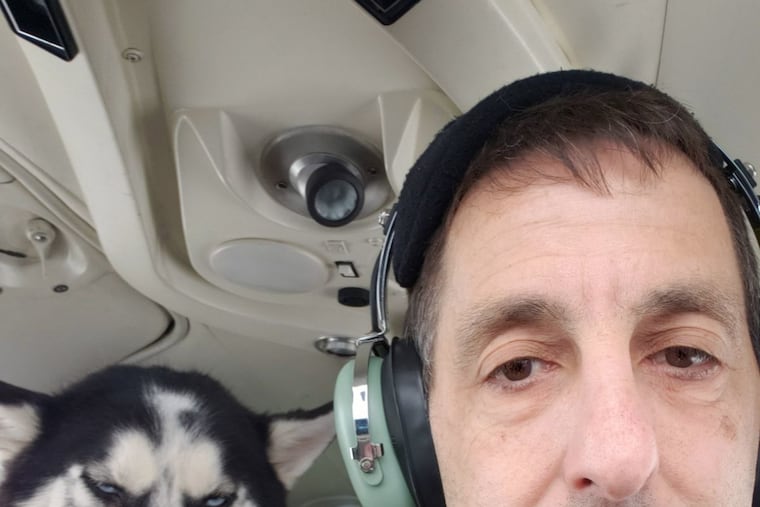These Philly pilots fly dogs across the East Coast to save their lives. For free.
“I can literally be the missing link to whether or not an animal lives or dies.”

Over the course of about 40 flights on his private plane, Al Ciardi has helped save 75 dogs, three cats, and 27 chickens.
He remembers the animals — those that have slept, barked, and sat copilot in his plane over the last year and a half while he’s volunteered with an organization that transports rescues — because he photographs them all and hangs the pictures in his Fairmount home.
There was Roxy, the deaf pooch from North Carolina he fostered for a night and who made fast friends with his daughter (a human). There was Duke, the husky-border collie mix who was a bit of a runt and acted right at home in the plane. There was Cliff, a husky who was shot in South Carolina and brought north for surgery, then adopted by a family from the Main Line.
And yes, there was a time when the back of Ciardi’s four-seat Piper Archer plane was stuffed with a couple of dozen chickens he was transporting from Philadelphia to a shelter in Virginia. “They’re not as fun as dogs,” he admitted.
Ciardi, a 52-year-old bankruptcy lawyer who flies in and out of Northeast Philadelphia Airport, is one of a couple of hundred pilots in Pennsylvania and New Jersey who volunteer with Pilots N Paws, a nonprofit that, through an internet forum, connects rescue organizations with pilots willing to transport animals to and from shelters across the country. The only reward for those who make the trips is a potential tax write-off and the good company of a dog as a copilot.
Since the service was founded in 2008, and others like it popped up, pilots have become an integral part of the national animal-rescue apparatus that relies heavily on volunteers to provide transportation. Most commonly, the animals are being transported from rescues in Southern states, where there’s a surplus of adoptable dogs and cats, to the North, where there’s a shortage and where more shelters don’t euthanize healthy animals.
And while trucks and cars can get the job done, planes cut the transit time considerably. Not to mention, those involved in the process say the rescued animals are like babies in cars: the loud whir of a plane’s engine gently lulls them to sleep.
“There’s such a huge imbalance of available animals across the country that it became almost impractical to drive every one, so [we’re] looking for every possible way to move them from one part of the country or the other to save their lives," said Marsha Perelman, a director of the Humane Society of the United States and one of the Philadelphia area’s most recognized animal welfare advocates.
Volunteer pilots, she said, have helped fill the void.
“Everybody’s a winner here. I’m having fun,” Ciardi said. “The people that do the hard work are the fosters and the rescue [organizations]. They really have the tough job.”
Here’s how it works: Rescue organizations post on the Pilots N Paws website when they need to transport a dog (or cat or rabbit or reptile or chicken) from one location to another. Sometimes it’s from a shelter that uses euthanasia to a no-kill shelter; other times it’s from a rescue organization to a furever home.
Then, the trip pops up on a map that’s accessible to the organization’s 5,000-plus pilots around the country. Those willing to help will comment on the thread, indicating where they can pick up the animal, where they can take it, and what times work for them. From there, the rescue organization will coordinate, oftentimes with multiple pilots, to confirm flight times that will get the animal where it needs to go.
Once the pilot picks up the animals, the smaller dogs, puppies, cats, and the like are typically crated, while larger dogs are sometimes (luckily enough for them) tethered to a seat, allowing them to peer out the window while flying. This process happens every day, many times over, and has added up to 200,000-plus animals saved over the course of the last decade.
» READ MORE: Teenage genealogist has a gift for linking your past to your present
Paul Steklenski, the founder of Flying Fur Animal Rescue, a nonprofit based in Zieglerville, Montgomery County, used to work with Pilots N Paws but broke off on his own with the hopes of transporting more animals.
The 46-year-old today works full time as a network engineer so he can afford to rescue animals on flights twice a month. Since 2015, he’s transported more than 1,300 critters — mostly dogs.
Steklenski said it costs about $1,000 monthly out-of-pocket to do what he does. It hasn’t deterred him yet. In fact, he’s hoping to grow by raising enough money to one day purchase land in the area and run a rescue of his own.
He got into this work around 2013, after he adopted Tessa, a Labrador mix, from a pet shop in Boyertown. Around the same time, he was learning to fly.
But his story isn’t as much about aviation as it is about how Tessa — her innocence, her love, the way she made him feel — changed his life. He wanted to share that indescribable feeling with others, and decided he could do that by transporting animals for the rescue organizations that need it.
“I can literally be the missing link,” he said, “to whether or not an animal lives or dies.”